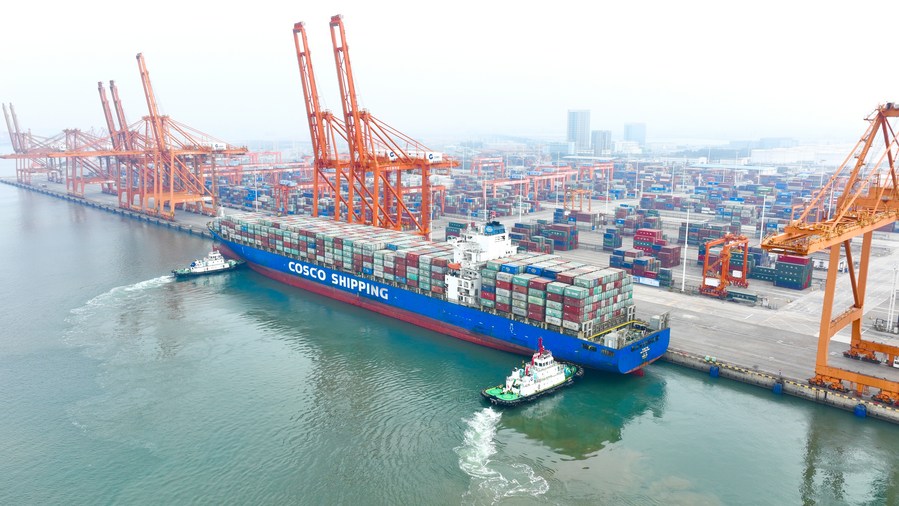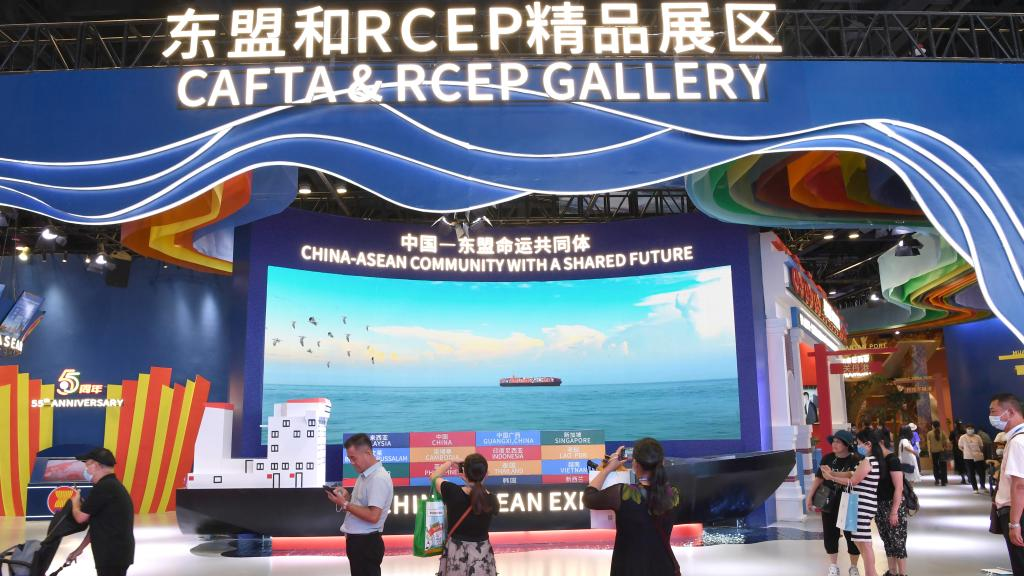
The container terminal of Qinzhou Port in the Guangxi Zhuang Autonomous Region, China, March 2, 2022. /Xinhua
The container terminal of Qinzhou Port in the Guangxi Zhuang Autonomous Region, China, March 2, 2022. /Xinhua
Editor's note: Liu Chunsheng is an associate professor at the Beijing-based Central University of Finance and Economics. The article reflects the author's opinion, and not necessarily the views of CGTN.
2022 witnessed the first year that the Regional Comprehensive Economic Partnership (RCEP) officially came into force.
On January 1, 2022, the day the RCEP took effect, the tariff rates of a large number of products were reduced to zero immediately. Zero tariff has reduced the cost of imported goods, combined with high-level trade facilitation measures, consumers can purchase imported goods at a lower price and more convenient manner.
As a free trade area with the largest population, the biggest economic and trade scale and the greatest development potential in the world, the RCEP takes trade liberalization and facilitation as the primary condition, and stands committed to establishing a high-quality free trade area that gradually eliminates all tariffs and non-tariff barriers.
The principle of regional value accumulation is used by the RCEP in this region, so that the value components of products' origin can be accumulated in the region composed of 15 member countries. The value components from any party of the RCEP will be taken into account, which will upgrade the utilization rate of the preferential tax rate under the agreement.
After the RCEP took effect, the reduction of tariffs, the simplification of customs clearance procedures and the increase of regional trade profits have effectively enforced the cooperation between RCEP partners. The tariffs reduction and high-level economic and trade rules have played a positive role in regional trade and investment, industrial chain, supply chain and value chain.
Enterprises rely on the comparative advantages of member countries to carry out cross-border combination and integration, optimize the layout of regional production networks, and improve comprehensive productivity and product competitiveness. In such process, each member country could participate in and elevate its position in the regional value chain, and promote the formation of a win-win regional cooperation pattern.

The CAFTA and RCEP Gallery during the 19th China-ASEAN Expo, Guangxi Zhuang Autonomous Region, China, September 19, 2022. /Xinhua
The CAFTA and RCEP Gallery during the 19th China-ASEAN Expo, Guangxi Zhuang Autonomous Region, China, September 19, 2022. /Xinhua
The RCEP has made important breakthroughs in economic and trade rules and enhanced the level of liberalization and facilitation. In terms of goods trade, the RCEP implemented unified rules of origin in the region, and more convenient customs procedures and trade facilitation provisions.
In terms of service trade, the RCEP flexibly set commitment rules for service trade access, improve the overall level of commitment in the financial sector, and add new provisions in telecommunications annexes. In terms of investment, the RCEP members adopted a negative list to reduce market access restrictions for non service sectors and upgrade the transparency of investment rules.
Additionally, the comprehensive and high-level multilateral e-commerce rules were agreed by the RCEP in the Asia-Pacific region for the first time. Innovative intellectual property rights, competition, government procurement and other issues, as well as strengthened cooperation in small and medium-sized enterprises were discussed in RCEP negotiations.
In order to promote regional trade facilitation and create a favorable e-commerce environment, the RCEP agreement has established a special chapter on e-commerce, covering a number of key contents related to promoting the use and cooperation of e-commerce, along with promoting paperless trade, electronic authentication and signature, protecting the personal information of e-commerce users, protecting the rights and interests of online consumers, and strengthening regulatory cooperation on electronic information.
In addition, the parties reached consensus on cross-border information transmission, information storage and other issues in the agreement. This is a comprehensive multilateral e-commerce rule with the largest number of members reached in the Asia-Pacific region.
Today the world has entered a period of turbulence, economic globalization is met with a countercurrent, the international economic governance system and multilateral mechanisms have been challenged, and downward pressure on the global economy has been accumulating.
The RCEP is playing a crucial role to boost regional cooperation, which remains consistent with China's overall goal of expanding high-level opening-up. China will strengthen the coordinated development of the RCEP and the Belt and Road Initiative, enhance trade and investment liberalization and facilitation, and promote the transformation and upgrading of regional industrial cooperation and bolster integrated development of the regional economy.
The RCEP will drive the China-ASEAN market. China and ASEAN have promoted positive progress in a number of landmark projects. Since the RCEP came into fruition, it has accelerated the release of institutional dividends, making China-ASEAN economic and trade cooperation climb to a new level on the basis of the original free trade area.
(If you want to contribute and have specific expertise, please contact us at opinions@cgtn.com. Follow @thouse_opinionson Twitter to discover the latest commentaries in the CGTN Opinion Section.)